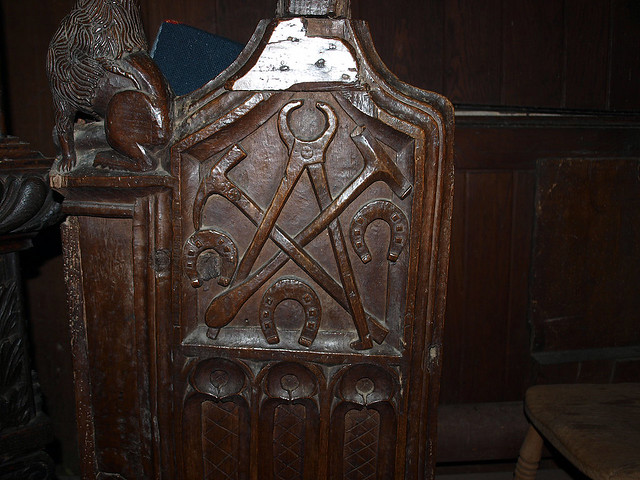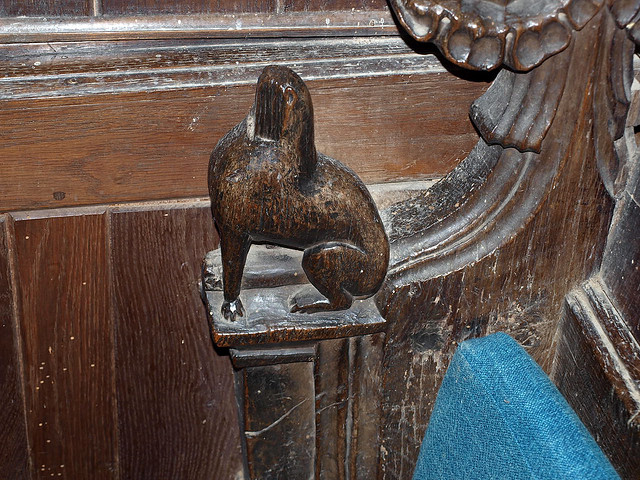ALL SAINTS. Finely moulded C13 S doorway. One C13 lancet window in the chancel. The chancel on the whole looks all C19. Original ogee-arched niche to the l. of the E window. Nave and N aisle Perp. The arcade piers have four semi-octagonal shafts. The capitals are treated as one band. Double-chamfered arches. S porch Perp, of brick with flushwork panelling. W tower of knapped flint with a spike.* Base-frieze of flushwork panelling. Dec W window. - PULPIT. On short bulbous legs. The body square, not polygonal. One tier of the familiar Elizabethan short blank arches, a tier with simple lozenge panels below. Back panel and tester. On the tester the date 1619. - BENCI-IES. Many, with poppy-heads and animals on the arms. - PANELLING. Behind the altar, in the style of the pulpit. - COMMUNION RAIL. With twisted balusters, c. 1700. - PLATE. Elizabethan Cup; Almsdish 1808.
* A will of 1460 leaves 6l. 8d. ‘Panneto de Asshfield’ - presumably the tower’s pinnacle (ARA).
GREAT ASHFIELD. In this flat land of many low-lying streams most of the older houses still have moats, and there are three moated houses hereabouts, the hall (now a farm) having a moat on two sides.
Flint panels adorn the face of the 15th century red brick porch of the 13th century church, where a sundial calls on us to Redeem the Time. Here is the original timbered roof and much fine carving. The bench-ends are solid and heavy and on an unusually large scale, but much defaced. We noticed on them the graceful sweep of an angel’s wing, the half-human face of a mythical beast, and the plumage of a bird. The canopied pulpit is magnificent, the work of one of those Jacobean craftsmen who have made so many of our churches beautiful by their skill. It stands high on a square base mounted on carved feet. There are diamond designs in the lower part, and the whole erection is a masterpiece of delicate work. The clerk’s bench has the symbols of the blacksmith’s craft, horseshoes, hammer, and pincers. The reredos harmonises with the pulpit in richness of design. An ancient chest is bound with many iron bolts and bands, and the 15th century font is raised on two high steps.
A window of lovely colouring was given in the early years of this century by three daughters in memory of their father and mother. In richest purples and blues adoring angels bow before Our Lord, and in smaller panels are the Sower and the Reaper. The eight men of the village who fell in the Great War are remembered on a marble tablet as “a band of men whose hearts God had touched.”
Towards the end of last century it was found necessary to restore the ancient framework on which the bells had swung for many generations to call the folk to prayer, and part of the old woodwork was carved as a memorial of the Jubilee of the Victorian Era.
Here at the rectory were born two famous brothers, Edward Thurlow, Lord Chancellor, and Thomas who became a bishop. Edward, first baron, born here in 1731, was the son of a clergyman and was expelled from his first school and from Cambridge University as incorrigible. While studying law he, a profane and truculent bully, had as a colleague in the same office the gentle poet Cowper, and one of the few creditable things in his life is his scholarly correspondence with him and his friendship with Dr Johnson. He attained fame in celebrated trials, entered Parliament, and became first Attorney-General and then, as a servile flatterer of George the Third, enemy of the American Colonies, and an opponent of reform, he was made Lord Chancellor, one of the worst and most bad-tempered Chancellors the nation ever had. By trimming and twisting he held his high office on three occasions, browbeating peers, bishops, judges, and counsel, undermining his colleagues for the advantage of the king, and disgracing his office until Pitt insisted that the king should choose between himself and his intolerable Chancellor.
Thurlow sought to regain influence through popular favour by unsaying all he had said in defence of privilege and tyranny, but the ruse failed and he retired from public life. He built a house at West Norwood, but quarrelled with his architect and never entered it. He was taken ill at Brighton in 1806, and his servants, when carrying him upstairs, accidentally struck his feet on the banisters. His last utterance was a curse upon them for their clumsiness.



No comments:
Post a Comment